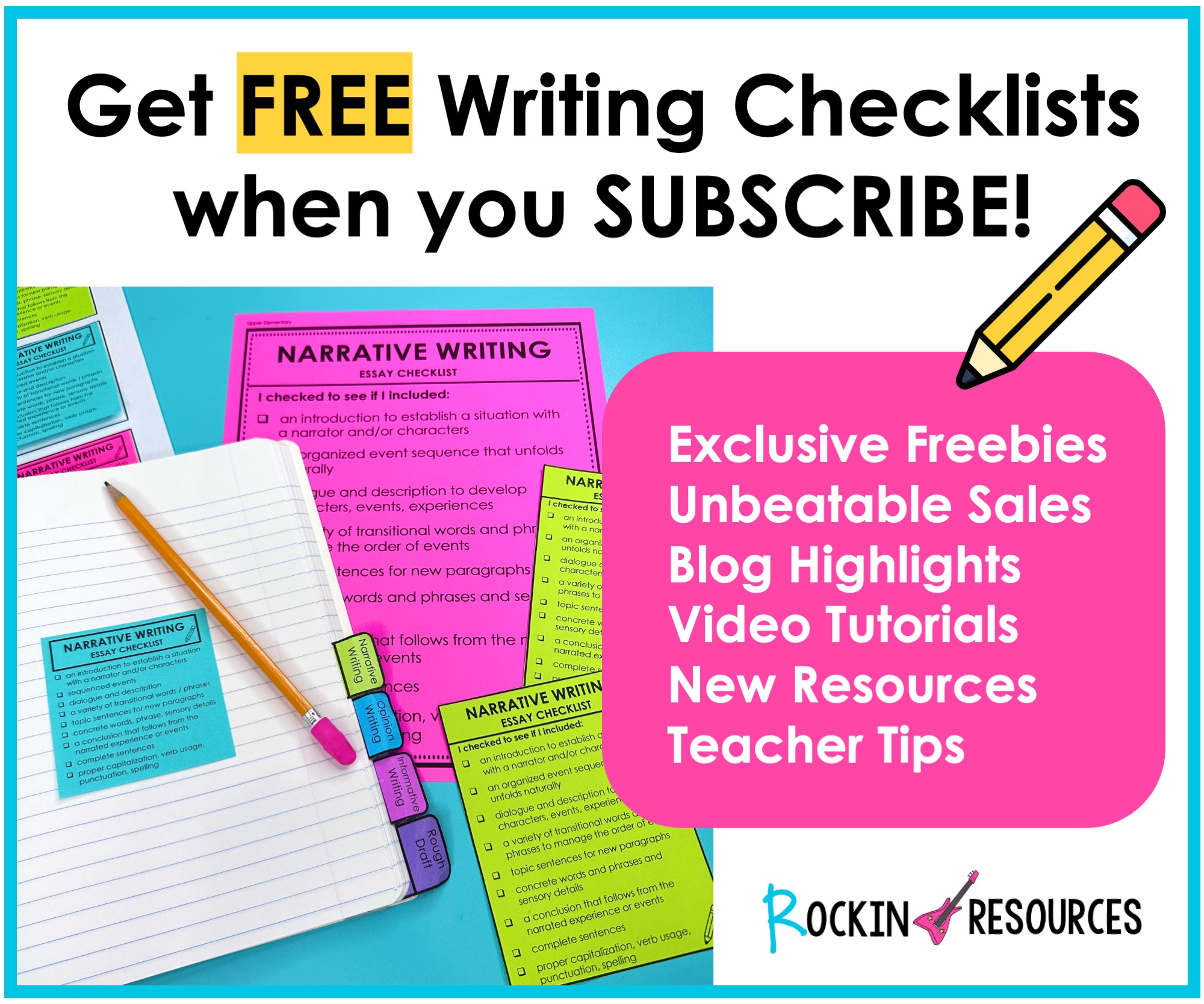Checklists are used for many academic tasks, and writing is a common one. Are they really effective? Absolutely! This post will explore why checklists are used, research results, and how to use writing checklists to improve student writing in the classroom.
Why Are Writing Checklists Used in the Classroom?
When children have the opportunity to address their own mistakes within the writing process, it makes their learning more meaningful. They can fix mistakes as they go and develop their writing skills that much faster. Think of famous authors like Roald Dahl or Judy Blume. Good writers use checklists, revise, and edit over and over again to get it just right.
A writing checklist is an effective tool to use when writing because…
- It guides students to develop the skills needed when writing.
- It shows reluctant writers a simple way to include the necessary elements.
- It provides a reference to use throughout the writing process.
- It helps students stay focused on each step of the process.
- It gives students tools for review and peer-editing.
- It ensures students include key elements of that particular type of writing.
- It encourages students to establish organization throughout their paper.
- It reminds students to “check over” their paper for effective revising strategies and proper editing rules.
- It holds students accountable by providing expectations.
- It keeps students on task.
- It ultimately helps significantly improve students’ writing.
- It can help communicate the criteria of an effective paper to parents.
- It can eliminate extra work for the teacher and student if the teacher grades the paper and wants the student to fix any mistakes.
- It can develop students’ metacognitive awareness of their intellectual processes (see research below).
What Research Supports the Fact that Writing Checklists Improve Writing?
There have been several studies to support the effectiveness of using checklists. Let’s take a closer look at their findings…
Dr. Kathleen Dudden Rowlands (Educational Specialist)
Kathleen Dudden Rowlands wrote an article titled Check it Out! Using Checklists to Support Student Learning. The article states, “Kathleen Dudden Rowlands recommends using checklists to support student learning and performance. Well-designed checklists identify steps students can take to complete complex tasks which scaffolds students’ metacognitive development and fosters the confidence and independence needed for internalizing these steps for future tasks.” Read more HERE!
Atul Gawande, MD, MPH (Surgeon and Writer)
Atul Gawande explores how experts in their fields need checklists to avoid mistakes and how checklists improve outcomes. The description of his book, “The Checklist Manifesto”, states, “Atul Gawande makes a compelling argument that we can do better using the simplest of methods: the checklists. In riveting stories, he reveals what checklists can do, what they can’t, and how they could bring about striking improvements in a variety of fields, from medicine and disaster recovery to professions and businesses of all kinds. And the insights are making a difference.” Read more about his book HERE!
Annette Marines (Librarian, USCS) and Aaron Zachmeier (Instructional Designer, USCS)
Marines and Zachmeier looked at how checklists improve writing, information literacy, and analytical thinking skills. In 2017, they studied several scenarios comparing results of students using a checklist with students who didn’t use a checklist. Their findings indicated that checklists help improve student performance. For more details, click HERE!
How Do You Use Writing Checklists in the Classroom?
Now that you know checklists are important and effective in the classroom, how can you use them for writing?
- When creating a writing checklist, think about the expectations of the task and what you want your students to accomplish. Are they writing a paragraph or an essay? What type of writing are you assigning? Make sure to include the elements of writing for that particular type of writing. For example, in narrative writing, checklist items might include: Do you have a beginning, middle, and end? Do you offer a solution to the problem? Did you develop the characters throughout the story? Did you provide suspense?
- Make sure the checklist is well-crafted, simply-stated, and in a practical order to guide the students through the assignment. Don’t make it too lengthy because you want your struggling readers to understand it as well.
- Tell students the purpose for the checklist. (It will guide you to a quality of writing and remind you of the expectations of the assignment. It will help you become an amazing author!)
- Tell students that experts like surgeons, pilots, and the best authors use checklists!
- Provide the checklist at the beginning of the assignment so they can use it throughout the writing process- pre-writing, rough draft, revising, editing, peer-editing, and final copy. Remind them to go over the checklist one more time before the publishing stage!
- Go through each item on the checklist. Demonstrate examples or use a mentor text to explain each step.
- Ask students to turn in the checklist with their published piece. This will help them realize its importance and make them accountable for the items on the checklist.
Writing checklists are found in all my Step-by-Step Writing Programs® which are aligned to each grade level. Do you want to try our FREE writing checklists aligned to primary or upper elementary grades for a variety of writing types? Click on the BOX below and see how to get them for FREE!
I hope you found some useful tips!






